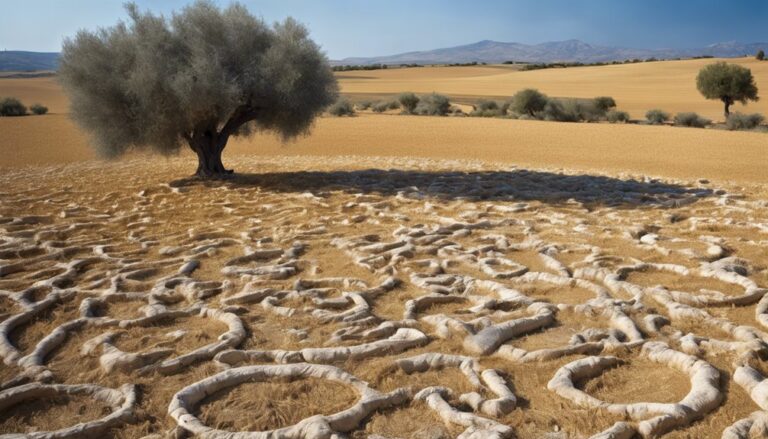To clean oil off your floor, start by identifying the oil type, then quickly cover fresh spills with absorbents like kitty litter or baking soda to soak it up. After removing the absorbents, mix dish soap with hot water to break down any remaining grease, scrubbing gently with an appropriate brush. Rinse thoroughly and dry to prevent slips. For stubborn stains, commercial degreasers work well. Follow these steps carefully, and you’ll avoid future messes while keeping your floor spotless—explore further tips for lasting results.
Identify the Type of Oil Spill

Before you begin cleaning, it’s crucial to identify the type of oil spill you’re dealing with, as this determines the appropriate cleaning method. Start by evaluating the spill sources—common ones include motor oil, cooking oil, hydraulic oil, or fuel oil. Recognizing these helps you select effective cleaning agents and techniques. Different oil types vary in viscosity, toxicity, and absorption properties. For instance, motor oil is thicker and often requires stronger degreasers, while cooking oil may respond well to mild detergents. You’ll also want to take into account whether the spill is fresh or has set, as older spills can be more challenging to remove. By precisely identifying your spill’s characteristics, you maintain control over the cleanup process, ensuring you restore your floor efficiently and reclaim your space without unnecessary restrictions.
Gather Necessary Cleaning Supplies
Once you’ve identified the type of oil spill, the next step is to gather the right cleaning supplies tailored to that specific oil. Start with effective oil absorbents—materials like kitty litter, sawdust, or commercial oil absorbent pads designed to soak up oil without spreading it. Select cleaning tools that suit your floor type; a stiff-bristled broom or brush works well on concrete, while softer brushes are better for delicate surfaces. You’ll also need protective gloves to keep your hands safe, and a dustpan or scraper to collect the absorbent afterward. For tougher stains, have a degreaser or a mild detergent ready. Gathering these supplies in advance guarantees you can act decisively, restoring your floor quickly and maintaining the freedom of a clean, safe environment.
Absorb Fresh Oil Spills Quickly

When you spot fresh oil on the floor, act quickly by covering the spill with absorbent materials like paper towels or kitty litter. Sprinkle baking soda over the area to help draw out the oil, then gently blot the surface—avoid rubbing to prevent spreading the stain. This method guarantees you remove as much oil as possible before it soaks deeper into the floor.
Use Absorbent Materials
Although oil spills can spread quickly, you can minimize the damage by immediately applying absorbent materials. Grab items like cat litter, sawdust, or commercial oil absorbents designed specifically for oil absorption. Sprinkle these materials generously over the spill to cover it fully. The absorbent particles will draw the oil upward, preventing it from seeping deeper into the floor. Allow sufficient time for absorption—usually 15 to 30 minutes—before proceeding. Once the oil has soaked in, use a broom or dustpan to carefully collect and dispose of the saturated material in accordance with local regulations. By promptly using absorbent materials, you control the spill’s spread and protect your floor’s integrity, giving yourself the freedom to clean effectively without letting the oil cause lasting damage.
Apply Baking Soda
Sprinkle baking soda generously over fresh oil spills to quickly absorb the liquid before it soaks into the floor. Baking soda excels at oil absorption, making it an ideal first response. Here’s how to apply it effectively:
- Cover the entire spill with a thick layer of baking soda.
- Let it sit for 10 to 15 minutes to maximize absorption.
- Carefully sweep up the baking soda with a dustpan or vacuum.
- Repeat if necessary to guarantee no oily residue remains.
Blot, Don’t Rub
Two key actions will help you tackle fresh oil spills effectively: blotting and avoiding rubbing. When oil spills, your goal is to absorb it quickly before it spreads or sinks deeper. Use blotting techniques—press absorbent materials like paper towels or clean cloths gently onto the spill. This draws the oil upward without pushing it around. Avoid rubbing, which can smear the oil, enlarging the stain and embedding it into the floor. Instead, apply steady, light pressure with absorbent materials, replacing them as they become saturated. By mastering these blotting techniques, you’ll efficiently lift oil off the floor’s surface, maintaining a cleaner area with less effort. This method preserves your floor’s integrity and grants you the freedom to handle spills confidently and effectively.
Use Baking Soda or Cat Litter for Absorption

When dealing with fresh oil spills on your floor, you’ll want to act quickly by applying an absorbent material like baking soda or cat litter. Both offer practical solutions: baking soda benefits include its natural absorbency and non-toxic nature, while cat litter effectiveness lies in its granular texture, which soaks up oil efficiently. Here’s how to proceed:
- Sprinkle a generous layer of baking soda or cat litter over the spill.
- Let it sit for at least 15-20 minutes to absorb the oil thoroughly.
- Carefully sweep up the powder with a dustpan or vacuum it.
- Dispose of the used material responsibly to avoid environmental harm.
Using these absorbents gives you control and freedom to manage spills without harsh chemicals.
Apply Dish Soap and Hot Water for Grease Removal
Although absorbents like baking soda or cat litter help lift fresh oil, stubborn grease stains often require a more targeted approach using dish soap and hot water. Start by mixing a few drops of dish soap into a bucket of hot water—this combination breaks down the oil’s molecular structure, making it easier to remove. Pour the soapy hot water onto the affected area, allowing it to sit for a few minutes to penetrate the grease. The heat from the water enhances the soap’s effectiveness, loosening the oil’s grip on the floor. Afterward, gently blot the area with a clean cloth or sponge to lift the loosened oil. This method guarantees thorough grease removal while preserving your floor’s surface, giving you the freedom to maintain a clean, oil-free environment.
Scrub Stubborn Oil Stains With a Brush
After applying dish soap and hot water, some oil stains might still cling stubbornly to your floor. To tackle these, you’ll want to employ specific scrub techniques using the right brush types. Here’s a methodical approach:
- Choose a stiff-bristled brush for concrete or tile, and a softer nylon brush for delicate surfaces.
- Dip the brush into hot, soapy water to loosen the oil.
- Apply firm, circular scrubs directly on the stain, focusing on edges to prevent spreading.
- Rinse frequently, checking progress to avoid over-scrubbing.
Utilize Commercial Degreasers for Tough Stains
When tackling tough oil stains, selecting an effective commercial degreaser is essential for ideal results. You’ll want to apply the product according to the manufacturer’s instructions, ensuring even coverage and sufficient dwell time. Remember to follow safety precautions like wearing gloves and ventilating the area to protect yourself during the cleaning process.
Choosing Effective Degreasers
Since household cleaners might not always break down stubborn oil residues, choosing an effective commercial degreaser is essential for tough stains. You’ll want to evaluate several factors to select the right product:
- Identify degreaser types—solvent-based for heavy-duty stains or water-based for lighter messes.
- Opt for eco friendly options to reduce environmental impact without sacrificing power.
- Check the product’s material compatibility to protect your floor’s surface.
- Review user feedback on stain removal efficiency and safety.
Application Techniques for Stains
Selecting the right commercial degreaser sets the stage for effective stain removal, but applying it correctly is equally important to restore your floor. Begin by thoroughly sweeping the area to remove loose debris. Next, apply the degreaser directly onto the oil stain, ensuring full coverage. Let it sit for the manufacturer’s recommended time to break down stubborn oils. Use a stiff-bristled brush to agitate the stain gently, enhancing the cleaning techniques’ effectiveness. Afterward, rinse the area with warm water, removing all residue. Repeat this process if necessary, especially for persistent stains. By following these precise application techniques, you’ll maximize the degreaser’s power, achieving thorough stain removal and reclaiming your floor’s clean, oil-free surface.
Safety Precautions and Tips
Using commercial degreasers to tackle tough oil stains requires careful attention to safety to protect yourself and your surroundings. Before you start, gear up with the proper protective gear—gloves, goggles, and a mask—to shield your skin, eyes, and lungs from harmful chemicals. Next, guarantee effective spill containment to prevent the degreaser from spreading and causing slips or environmental damage. Follow these key steps:
- Read and follow the manufacturer’s instructions on the degreaser label.
- Work in a well-ventilated area to avoid inhaling fumes.
- Apply the degreaser directly to the stain, avoiding excess runoff.
- Dispose of any contaminated materials according to local hazardous waste guidelines.
Rinse and Dry the Floor Properly
Although you’ve already loosened and absorbed the oil, rinsing the floor thoroughly is vital to remove any remaining residue. Start by selecting an appropriate rinse technique—using warm water combined with a mild detergent works well to break down leftover oil particles. Apply the solution evenly and scrub gently with a soft-bristle brush or mop to avoid damaging the floor surface. Once rinsed, it’s important to dry the area promptly to prevent slips and further staining. Opt for effective drying methods like using absorbent towels or a microfiber mop to soak up moisture. If possible, increase air circulation with fans or open windows to speed up drying. By carefully rinsing and drying, you guarantee a clean, safe floor, maintaining your freedom to move without worry.
Prevent Future Oil Spills and Stains
To prevent future oil spills and stains, you’ll want to use drip pans whenever working with oil to catch any leaks. Consistent floor maintenance helps identify and address minor spills before they set in. Additionally, storing oil containers properly reduces the risk of accidental spills.
Use Drip Pans
One effective way to prevent future oil spills and stains is by placing drip pans under your vehicle or machinery. Drip pan benefits include catching leaking oil before it touches your floor, making cleanup simpler and avoiding costly damage. For effective prevention, consider these steps:
- Select a drip pan sized appropriately for your equipment to guarantee full coverage.
- Position the pan directly beneath the oil leak source for maximum efficiency.
- Regularly empty and clean the drip pan to maintain its function and avoid overflow.
- Use durable, chemical-resistant materials to withstand prolonged exposure and prevent deterioration.
Regular Floor Maintenance
Placing drip pans helps catch leaks, but maintaining a clean floor is equally important to prevent oil stains and slips. Establish a consistent maintenance schedule focused on thorough floor cleaning to reduce buildup and spot potential leaks early. Use absorbent mats or specialized floor cleaners designed for oil to enhance effectiveness. Regularly inspect your workspace for spills, addressing them immediately to keep the floor safe and stain-free. Document each cleaning session to monitor progress and adjust your maintenance schedule as needed. This methodical approach not only preserves your floor’s condition but also promotes a safer environment, giving you the freedom to work without worries about slipping or long-term damage. Staying proactive in floor maintenance is the key to preventing future oil-related issues efficiently.
Store Oil Properly
Properly storing oil in three key ways can greatly reduce the risk of spills and stains. To maintain a clean floor and enjoy your space freely, focus on these essential oil storage tips:
- Choose the right container types—opt for airtight, durable containers made of metal or high-density plastic to prevent leaks.
- Store containers on stable, elevated surfaces to avoid accidental tipping and facilitate easy cleaning if spills occur.
- Label each container clearly with contents and date to guarantee proper rotation and avoid using degraded oil.
- Keep oil storage areas well-ventilated and away from direct sunlight or heat sources to maintain oil quality and reduce hazard risks.
Maintain Clean Floors With Regular Upkeep
Although oil stains can seem stubborn, maintaining clean floors is much easier when you establish a consistent cleaning routine. Start by creating a floor maintenance plan that fits your space and usage. Set a cleaning schedule—daily or weekly—depending on the traffic and oil exposure. Use appropriate degreasers for quick spot cleaning before stains set in. Regular sweeping and mopping prevent dirt buildup, which can trap oil residues. Don’t ignore minor spills; addressing them promptly saves time and effort later. By sticking to this disciplined approach, you’ll preserve your floors’ integrity and enjoy a safer, more pleasant environment. Consistency is key—your freedom from tough oil stains depends on the simple habit of regular upkeep, ensuring your floors stay clean and damage-free over time.




